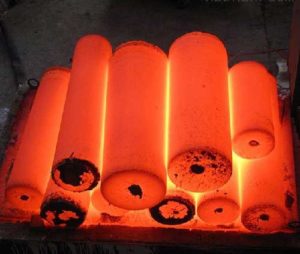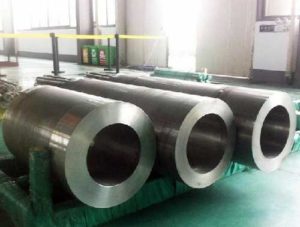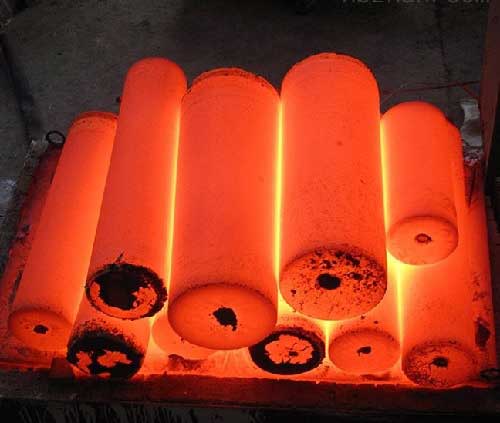Superalloy element strengthening.(HY-industry technical centre)
Alloying element classification
Most alloying elements are transitional elements in the periodic table, and their effect on phase stability depends mainly on their position in the periodic table, such as:
-
Ni, Co, Fe, Cr, Mo, Re, and W, etc., are usually dissolved in the γ matrix to stabilize the γ matrix, and their atomic radii differs from the Ni element by a large amount;
-
Al, Ti, Nb, Ta, etc., which are relatively larger than the atomic radii of the Ni element, which promote the precipitation of the ordered phase γ’ phase;
-
B, C, and Zr, etc., which tend to precipitate at grain boundaries, where Cr, W, Nb, Ta, and Ti are all strong carbide forming elements, while Cr and Mo promote the precipitation of boride.
main function
-
 The strengthening of the first to third alloying elements in the superalloys can be mainly divided into solid solution strengthening, precipitation strengthening and grain boundary strengthening.
The strengthening of the first to third alloying elements in the superalloys can be mainly divided into solid solution strengthening, precipitation strengthening and grain boundary strengthening.
Solid solution strengthening:
Representative grades: GH3030 (Cr20Ni80), GH3625 (Inconel625), etc.
-
A suitable alloying element (solid solution strengthening element) is added to the nickel-based superalloy, and the alloy atoms are uniformly dissolved in the austenite matrix of the face-centered cubic structure to form a certain internal position; and when an austenite matrix appears The non-uniform distribution of solute atoms or the presence of short-range order hinders the movement of dislocations. Therefore, the resistance of dislocation motion is larger than that of pure metal, which acts as a solid solution strengthening. In other words, the role of the solid solution strengthening element is to increase the strength of the matrix, thereby increasing the room temperature or high temperature strength of the alloy. Solid solution strengthening requires alloy elements to have a large solid solubility and a high strengthening coefficient.
-
The solid solubility of alloying elements in a superalloy in a matrix can be expressed by a function related to atomic diameter: dNi[100(di-dNi)/dNi], where i is the alloying element and di is the atomic diameter of the i element. dNi is the atomic diameter of the Ni element. If the value of this atomic size of an alloying element i is between -15 and +15, then the alloying element has a certain solid solubility in Ni. The solid solution strengthening element mainly increases the strength of the matrix by increasing the resistance of the dislocation motion. When the solid solution strengthening alloy element is added, the stacking fault energy is reduced, the lattice structure of the matrix is distorted, and the shear modulus is also changed, so that the dislocation motion is more difficult. Pelloux and Grant found that when the alloying elements have similar effects on the lattice constant, in the periodic table, the alloying elements farther away from the Ni element can increase the flow stress of the matrix. Because when they are far apart, it means an increase in electron vacancies (such as elements such as Co, Fe, and Cr) and an increase in electron concentration (such as elements such as Zn and Al). At the same time, the addition of alloying elements farther away from the Ni element in the periodic table can also reduce the stacking fault energy of Ni. Therefore, the alloying element which is slightly larger than the atomic radius of the Ni element and which is located farther away from the Ni element in the periodic table of the element is more capable of solid solution strengthening.
Precipitation strengthening:
 Representative grades:GH4169 (Inconel 718), GH2026 (Refractaloy26), GH4090 (Nimonic90), etc.
Representative grades:GH4169 (Inconel 718), GH2026 (Refractaloy26), GH4090 (Nimonic90), etc.
-
The γ’ phase precipitated in the superalloy with the γ matrix is the main strengthening phase. The γ’ phase and the γ matrix phase have the same face-centered cubic crystal structure, but the lattice constants of the γ’ phase and the γ matrix phase are slightly different, and coherent strain is generated, thereby causing a high elastic stress field around the γ’ phase. Block dislocation movement. The lattice mismatch between the γ’ phase and the γ matrix phase can be calculated by the following formula. The larger the lattice constant of the γ’ phase and the γ matrix phase, the larger the lattice mismatch, and the stronger the stress field around the γ’ phase, the more significant the strengthening effect is.
Both the lattice mismatch between the γ’ phase and the γ matrix phase and the increase in the volume fraction of the γ’ phase can increase the yield strength caused by precipitation strengthening. Therefore, all alloying elements (Nb, Ti, Ta, etc.) capable of increasing the lattice constant aγ’ of the γ’ phase can increase the coherent strain around the γ’ phase, thereby providing a significant strengthening effect. Most of the alloying elements (Mo, Fe, Cr, etc.) entering the γ austenite matrix phase can increase the lattice constant of the γ phase, thereby reducing the coherent strain between the γ’/γ phases.
-
Precipitating phase particles dispersed in the γ matrix phase of the superalloy. When these reinforcing phase particles are harder than the matrix, the strength is higher than the matrix, the particle spacing is larger, or there is no coherent relationship between the dispersed particles, the motion dislocation cannot be cut. Classy points, and can only cross these obstacles by way of bypass. When strengthened by the Orowan bypass mechanism, the increase in alloy yield strength is only related to the average spacing of the particles. When the size of the reinforcing phase particles is constant, the volume fraction of the second phase is increased, and the average distance between the particles of the second phase is decreased, so that the strength is increased. As the second phase particles grow, the average distance between the two particles decreases, thereby increasing the yield strength.
-
The strength of the superalloy is related to the inverse domain boundary energy or stacking fault energy, volume fraction and size of the dislocation-cut γ’ phase. The interaction between dislocation and precipitation phase is the main strengthening essence. When high-temperature creep occurs in iron-based or nickel-based superalloys, the interaction between the motion dislocation and the γ’ phase usually shows that under higher stress conditions, the dislocations cross the γ’ phase through the cutting or Orowan mechanism, and the creep deformation is higher. The rate proceeds. In a nickel-base superalloy with a high volume fraction of precipitated phase, the critical stress of the dislocation cut through the γ’ phase is less than the Orowan bypass stress. Therefore, the dislocation cutting mechanism always takes precedence. Only at the end of long-term creep, the γ′ phase precipitates coarse particles, and the bypass mechanism can become a creep deformation mechanism. When the applied stress is low enough to actuate the dislocation cutting mechanism or the Orowan bypass mechanism, the creep deformation can only cross the reinforcing particles by means of dislocations in a thermally activated climbing manner. In the long-term aging process of alloys, according to LSW (Lifshitz-Slyozov-Wagner) theory, the γ’ phase coarsening kinetics has the following regularity: d3-d03=kt (where d is the γ’ phase size after aging, and d0 is the original γ’ The phase size, k is the γ’ phase growth rate, and t is the aging time).
-
The amount of precipitation strengthening phase is the most important factor in strengthening superalloys. Whether it is an iron-based superalloy or a nickel-based or cobalt-based superalloy, almost all of them are strengthened by increasing the number of γ’ precipitated phases. Although the composition of different alloy systems differs greatly and the preparation process is quite different, their room temperature and high temperature strength increase with the increase of the amount of γ’ phase precipitated in the alloy. Also, the permanent strength of the superalloy increases as the volume fraction of the γ’ phase increases. Generally, the volume fraction of the γ’ phase increases with the content of Al+Ti added to the alloy, which increases the number of γ’ phases in the superalloy, and accordingly increases the creep resistance and durability of the superalloy. Therefore, the precipitation amount of the precipitation strengthening phase is a key and fundamental factor determining the strength of the superalloy.
-
The size and spacing of the γ’ strengthening phase is a very important parameter in superalloys, and the suitable size of the γ’ phase is 10 to 50 nm. In the Ni-Cr-Al-Ti alloy, the room temperature hardness initially increases with the increase of the γ’ phase, and then decreases as the γ’ phase continues to increase. This is because the γ’ phase is mainly the cutting mechanism. It works, and when the γ’ phase is large, it is mainly the Orowan bypass mechanism. For the Orowan bypass and climb mechanism, the γ’ phase size is expected to be small, because in the case of the same total γ’ phase, the smaller the spacing between the γ’ phases, the higher the intensity. For the dislocation cutting mechanism, it is desirable that the γ’ phase is larger and the intensity increases as the particle increases. However, there is a critical dimension, which is less than the critical dimension. The cutting mechanism plays a major role. The larger the γ’ phase size, the better the strengthening effect and the higher the strength. Above the critical dimension, the Orowan mechanism plays a major role. The larger the γ’ phase size, the worse the strengthening effect and the lower the strength. The critical dimensions of the gamma prime phase are also different in different alloy systems.
Grain boundary strengthening:
Representative grades:Inconel600,Incoloy901,etc.
-
 The grain boundary is an obstacle to dislocation motion under low temperature deformation conditions, and is advantageous for room temperature and medium temperature strength. However, when the temperature rises, the grain boundary hinders the dislocation motion, and the dislocation of the grain boundary region easily disappears with the grain boundary defect and disappears, and the grain boundary slip occurs, so that it is used above the isothermal temperature. High temperature structural components are detrimental. The grain boundary becomes a weak link at high temperature, and the grain boundary deformation increases with the increase of temperature. Under certain conditions, the contribution of grain boundary deformation to the total deformation can reach 50%. The slippage of grain boundaries and the formation of grain boundary pores at high temperatures usually cause failure of the nickel-based alloy. Therefore, strengthening the grain boundaries is an important part of high-temperature alloy strengthening. In order to suppress or retard the intergranular cracking of the superalloy at a high temperature, the grain boundary is often strengthened by precipitation of carbides at the grain boundaries.
The grain boundary is an obstacle to dislocation motion under low temperature deformation conditions, and is advantageous for room temperature and medium temperature strength. However, when the temperature rises, the grain boundary hinders the dislocation motion, and the dislocation of the grain boundary region easily disappears with the grain boundary defect and disappears, and the grain boundary slip occurs, so that it is used above the isothermal temperature. High temperature structural components are detrimental. The grain boundary becomes a weak link at high temperature, and the grain boundary deformation increases with the increase of temperature. Under certain conditions, the contribution of grain boundary deformation to the total deformation can reach 50%. The slippage of grain boundaries and the formation of grain boundary pores at high temperatures usually cause failure of the nickel-based alloy. Therefore, strengthening the grain boundaries is an important part of high-temperature alloy strengthening. In order to suppress or retard the intergranular cracking of the superalloy at a high temperature, the grain boundary is often strengthened by precipitation of carbides at the grain boundaries. -
Trace elements that are segregated to a grain boundary within a certain range to improve the grain boundary bonding force and improve the properties of the superalloy, such as C, B, Mg, Zr, Hf, and rare earth, etc., which will segregate to the grain boundary and reduce the grain boundary energy. Reduce the system’s free energy. At the same time, the atoms of harmful trace elements are segregated to the grain boundary according to this rule, but the atoms of the beneficial trace elements are segregated to the grain boundary to increase the bonding force of the grain boundary by changing the bonding state between the grain boundary atoms, thereby improving the high temperature strength of the alloy. And the harmful trace elements are segregated to the grain boundary to reduce the grain boundary bonding force. In addition, the dislocations blocked near the grain boundary may induce the generation of intragranular dislocations and the start of the multi-slip system after reaching a certain density to coordinate the deformation between the crystal grains without separating the adjacent crystal grains. Thereby improving the fracture plasticity of the alloy. For example, the B element is segregated to the grain boundary to enhance the grain boundary bonding force, so that the FeAl alloy room temperature tensile fracture changes from intergranular to transgranular. The beneficial trace elements are segregated to the grain boundary to suppress the harmful impurities and their compounds to segregate and precipitate at the grain boundary, and change the morphology of the grain boundary precipitate phase.
-
The addition of trace beneficial elements to the superalloy can prevent the generation of low-melting compounds or eutectic of harmful impurities such as S and Pb at grain boundary segregation and formation of harmful impurities, and improve the ability of the grain boundary to resist the formation of pores and cracks. At the same time, the beneficial elements are segregated at the grain boundaries, changing the phase interfacial energy, facilitating the aggregation and spheroidization of the grain boundary precipitation phase, and preventing and eliminating the precipitation of the grain boundary flake and cell phase. Thereby improving the durability and plasticity of the alloy, reducing the creep rate and improving the notch sensitivity. The beneficial trace elements combine with harmful impurities in the liquid phase of the superalloy to form a high melting point compound, thereby avoiding or eliminating the harmful effects of the segregation of harmful impurity elements at the grain boundaries. Ca has strong affinity with O and S. When non-vacuum smelting high-temperature alloys, it often reduces the O and S content by “calculating calcium” to remove the compound from the slag, thereby purifying the grain boundary, improving the performance and improving the heat. Processing plasticity and yield. The rare earth element also has a high affinity for O and S, and the rare earth element can also more fully remove O and de-S, thereby increasing the grain boundary strength. The high temperature segregation of beneficial trace elements causes grain boundary enrichment, while the low temperature heat treatment results in grain boundary precipitation phase.
-
The grain boundary precipitation phase has a significant effect on the grain boundary strength and plasticity through the following mechanisms:
-
hinder the sliding of the grain boundary, act as a pinning, or slow down the sliding speed, and prolong the sliding incubation period. When the carbon content is 0.03~0.05 wt.%, the long-lasting time of GH2135 peaks and the plasticity is good. This is mainly because the granular Ti C is distributed in the grain boundary, which prevents the sliding and migration of crystal grains along the grain boundary. To maximize the duration of time;
-
Limiting the cavities between the precipitated phases makes it difficult to aggregate and grow, thereby delaying the long-term rupture time. The creep rupture of superalloys is basically characterized by intergranular fracture. This is mainly due to the fact that during the creep process, vacancies accumulate at the grain boundaries, forming voids, growing into pores, and connecting the pores, thereby causing intergranular fracture. The precipitation phase of the beneficial element is distributed at the grain boundary, and the hole is prevented from being between the precipitate phases, making it difficult to develop, thereby prolonging the fracture time;
-
Produce a grain boundary depletion zone, improve the dislocation slip ability of the two sides of the grain boundary, improve the grain boundary plasticity, and eliminate the notch sensitivity. The most typical is that after heat treatment of Nimonic 80A alloy, Cr7C3 carbide precipitates on both sides of the grain boundary due to the precipitation of Cr7C3 carbide, which reduces the degree of solid solution strengthening on both sides of the grain boundary and improves the plasticity, which is beneficial to improve the durability plasticity and eliminate Notch sensitivity.


